In sous-vide forums and Facebook groups there are often debates about adding stuff to the bag when cooking meat sous-vide. Someone posts a photo of a piece of meat sealed with a lot of stuff in the bag, and someone else will comment that the person who posted the photo is stupid because those flavors will not penetrate into the meat. Sometimes this is accompanied by a theoretical explanation, that in some cases does not make any sense to me. I prefer practical evidence over theoretical assumptions, and so I put it to the test.
I started out with this nice slab of pork neck (part of a cut that is called pork shoulder in many regions), and cut it into six pieces of roughly equal size.
I then treated each of them differently, and cooked all of them for 48 hours at 57C/135F. I opted a cut of meat that would require a long cooking time to make sure that time would not be as much of an issue (as diffusion can be a slow process and during a short cook it could be expected that nothing would be able to penetrate very far into the meat). The six were:
- seared and with tomato sauce
- salt only
- nothing, just the pork
- rosemary and salt
- salted, then seared
- salt, pepper, ground fennel seed
I did not do one with butter or oil, as I will dedicate a separate article to that.
Since the long cooking at a temperature below 60C/140F can lead to the development of a bad smell, I scalded each of the bags in hot water after vacuum sealing to prevent that. Read more about why this is necessary here.
The experiments were also tasted by my husband, who did not know what I had put (or had not put) into the bag.
Rosemary
To see if any of the rosemary flavor had penetrated into the meat, I cut away the outside 1 cm (1/3 inch) of the pork…
…on all sides. I ended up with the inner piece of pork. And guess what? Neither of us could taste any rosemary in this inside piece. We did taste the salt though.
Although no rosemary flavor ended up inside the meat, my conclusion is not that adding rosemary when cooking meat sous-vide does not make sense at all. The pork juices that are left behind in the bag will be infused with a wonderful rosemary flavor.
I briefly seared the outside pieces with rosemary on them and afterwards deglazed the pan with the juices, which I then filtered (as juices from meat cooked at 57C/135F will coagulate when you heat them) and served with the meat. This was absolutely delicious. So yes, the rosemary flavor is only on the outside, but who cares? As long as you include some of the outside in each bite, it will taste of rosemary and you could not achieve this result by adding the rosemary only at the searing step.
Ground fennel seed, salt, and pepper
So we have established that herbs do not penetrate deeply into the meat. So what about spices? The ground fennel seed did not penetrate into the meat either, and neither did the black pepper. But like with the rosemary, the flavoring of the outside and the juices was delicious.
Tomato
For the next experiment, I made a tomato sauce by searing the meat first and then deglazing the pan with chopped tomatoes…
…and simmering the tomatoes to obtain a tomato sauce. After cooling I vacuum sealed the meat with the sauce, and cooked them together.
Although we could not detect any tomato flavor on the inside (and also from the color you can see that the tomato did not get far into the meat), we did have the impression that something had happened to the texture of the meat. Perhaps it is the acidity of the tomatoes? It is difficult to tell as pork neck is not a uniform cut of meat, so the difference we noticed could just have been caused by the particular part.
I used the tomato sauce in the bag, which had acquired a wonderful meaty flavor, to dress some pasta. It is traditional in Italy to eat the sauce with pasta first as primo piatto, which is then followed by the meat with some of the sauce as secondo piatto. (So you do not ever plate the pasta and the meat together.)
I was surprised by the outcome that the tomato had not penetrated deeply into the meat, as I had a different result when I tried this with oxtail. The oxtail was cooked at 60C/140F instead of 57C/135F and for 100 hours instead of 48, but I doubt whether that could have caused the different outcome. The difference in temperature is quite small, and we should have seen a deeper penetration of the red color after 48 hours if it had been the time difference. The best explanation I can come up with is that the oxtail has a different structure, where perhaps the tomato could penetrate in between the meat fibers rather than inside the meat fibers? I will have to do another experiment to figure this out.
Salt or no salt
In a previous experiment I had already compared between pre-salting and not pre-salting the meat when cooking sous-vide.
It was confirmed this time around that pre-salting leaves more juices inside the meat than not pre-salting: the pre-salted piece of pork neck lost 28% of weight (from 318 to 229 grams) during the 48 hour cook, whereas the pork neck without salt lost 35% of weight (from 254 to 166 grams). But you can see in the photo, and we could taste for ourselves, that the piece without salt actually appeared less dry with a different more compact texture. Again this seemed in part due to pork neck not being as uniform a cut as tenderloin, but still it was remarkable. The salted piece was nice because it was salted throughout instead of only on the outside (which was added when I served it).
Seared
Okay this is not really about adding stuff to the bag, but I also tried a piece that I seared before cooking it sous-vide.
It is not a surprise after the previous results that none of the browned flavors had ended up on the inside of the meat, but raw meat somehow browns more easily than meat that is already cooked sous-vide and the browned flavor of the crust is really good. Of course any crispness is lost by the step of sous-vide cooking, but this could be counteracted by briefly post-searing the pre-seared pork as well. Unfortunately I did not do a side by side comparison with pork that was only post-seared to determine the difference in flavor. (I am doing this for fun and all the pork you see in this post ended up as our dinner on different evenings. There is only so much pork you can eat in one sitting.)
Another advantage of pre-searing is that the juices in the bag will be more flavorful. I added a teaspoon of corn starch to the juices…
…whisked well, and then brought this to a boil while whisking. By using this technique, the juices will turn into a sauce without coagulating and with all the flavor that was in it. (If you allow the juices to coagulate and then filter out the ‘scum’, a lot of flavor will be filtered out as well.)
The color of the sauce is not the greatest, but the flavor is delicious.
Conclusion
So what do these experiments teach us? I think there are two important lessons:
- Except for salt, stuff that you add to the bag when cooking meat sous-vide will not penetrate deeply into the meat.
- That does however not necessarily mean that adding stuff to the bag does not make sense. Flavoring the outside of the meat is a perfectly good application of putting stuff in the bag, and it will also flavor the juices. Of course the latter only makes sense if you are actually going to use those juices for a sauce.
Flashback
A very appropriate flashback today: pulled pork sous-vide. This is also made of pork neck, but cooked for 24 hours at 74C/165F after it has been smoked. In this case the flavor of the seasoning and smoking is mixed through the meat after pulling it.






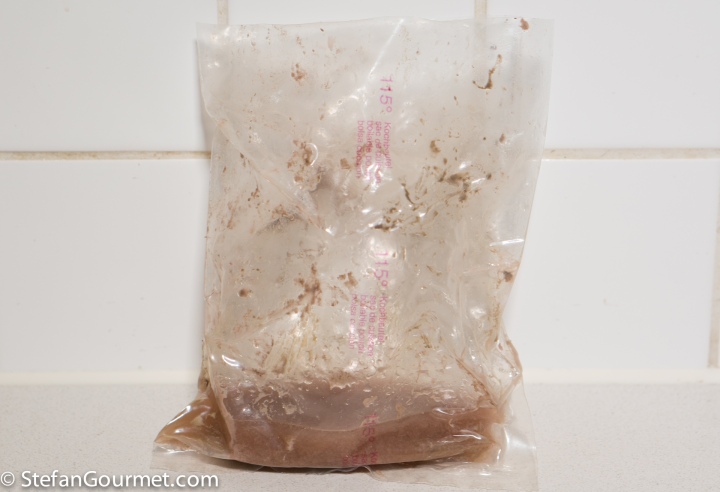

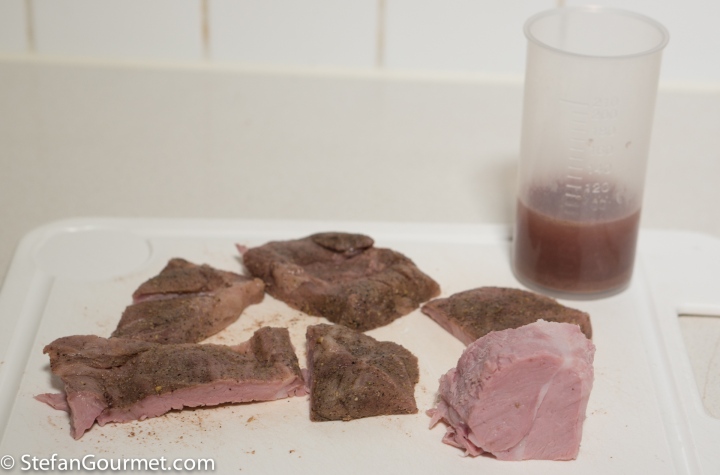
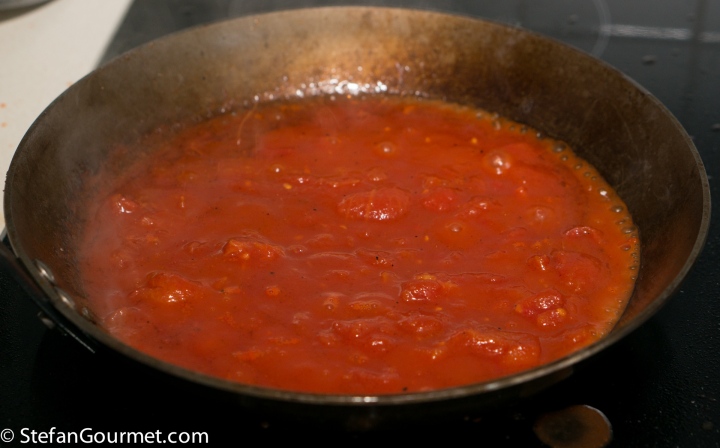




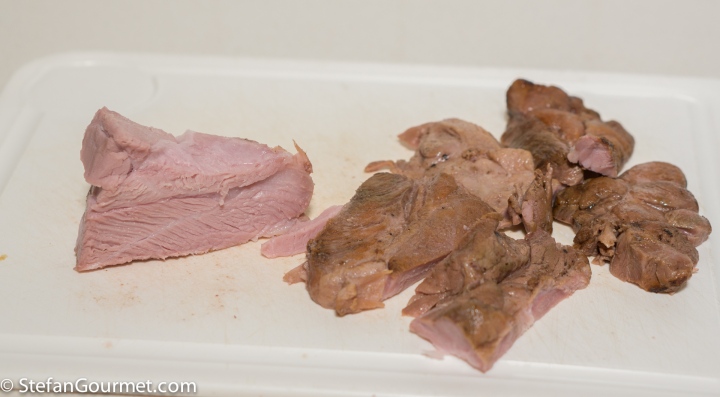
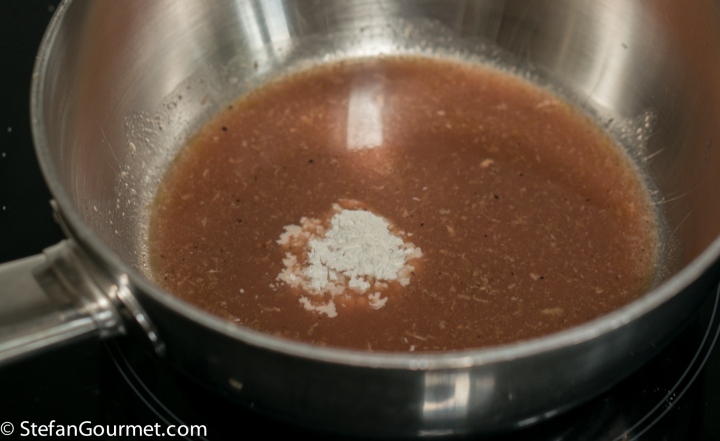


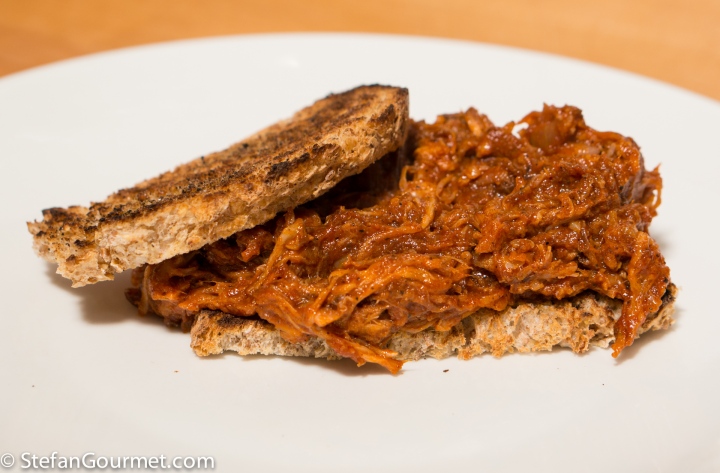

A fascinating read. However, I just marinated a tri tip in red wine and spices, and the wine flavor was definitely there after the whole process. I marinated for 48 hours, then cooked for 12 hours at 126 degrees F. then seared. It was fabulous. Interesting about the herbs and spices. Maybe try it again with actual marinades? Just a thought, because to me tomatoes aren’t a marinade, although there is an acidic component to them.
LikeLike
Hi Mimi, you are right that experiments always raise questions that require more experiments to answer them. Other than the tomato, I did not try an acid marinade. Like you, I know from experience that acid does penetrate into the meat. Just think about ceviche. It will also be interesting to compare vacuum sealing with marinade and then cooking sous-vide straight away, or to allow to marinate for 24 or 48 hours first and then cooking sous-vide. To paraphrase you: so many experiments, so little time.
LikeLike
Hahahahaha! I wouldn’t try an acid-based marinade with pork, though. Chicken breast might make for another set of experiments? Notice I keep suggesting more for you to do. I do enjoy your results! I have a marinade/marinating post coming up, and in it I mention that a certain test kitchen team tested marinades to see if they tenderized the meat, and the tests proved that they didn’t make the meat tender, but that flavor was definitely improved.
LikeLike
Well I can assure you that lemon juice added to chicken will make it much more tender when cooked sous vide. To the point that my attempt at chicken Tandoori was ruined. That reminds me I’ll have to try again and do a post about it.
LikeLike
Really? Interesting. These were the people behind Cook’s Illustrated. There was no sous vide’ing, just testing marinades and resulting tenderness.
LikeLike
Was there yogurt in the marinade in this case (the tandoori example) as well? If so, yogurt has a very big impact on tenderizing if you leave food in it too long. This plus lemon can soften tissue. The Modernist Cuisine books have long articles about the effects of acid on meat if you have those.
LikeLiked by 1 person
Very interesting experiment …
LikeLiked by 1 person
Great experiment and article.. I have said the same thing for a couple years. it got me kicked out of Norm King’s facebook group for questioning his logic on only doing sous vide with no seasoning in the bag.. it just did not make sense to me..
LikeLiked by 1 person
Nice work Stefan. A whole book can be written on this topic and the science behind it. It is…like many things in cooking…a complex question with no black and white answer but your final conclusions are pretty much a very good summation. After years of cooking SV I more often than not opt to include aromatics and flavorings in the bag. Yes, they do not “penetrate” BUT they do make a difference in the final product. After all, we are making dinner and consuming the whole, not the middle part of the the steak or chop.
Salt, now that is a different matter as you clearly noticed. I have a couple of rules of thumb for salting before SV.
1- Salt it if it is chicken/pork OR if it is a “tougher” piece of beef that will be cooked on a higher temperature. So, nothing that will be served like a medium or medium rare steak. Why? I really dislike the ham-like texture or almost cured texture that beef gets if salted. Chicken and pork on the other hand work with that texture.
2- For steak, I rarely if ever salt it before cooking. The texture suffers especially if I need to let it chill and reheated before consuming. I bag it with aromatics and fat, sometimes spices. If I have the time I pre-sear then post sear and season well.
Thank you for indulging my long-winded comment!
LikeLiked by 1 person
Thanks for the experiment!! I’m surprised that some of the flavours didn’t get further into the meat – in theory, a brine will penetrate, and I know a lot of chefs (or maybe cookbook writers) talk about stuff in brines?
Agree with the idea that the outside of the meat also matters!
Thanks again
LikeLike
I don’t throw people out of the group because they believe in infusion. I throw them out because they insist on DEBATING infusion, which is clearly prohibited in the group rules. If you stand on the beach and watch the sunset, the world appears to be flat. But, it’s not, and you wouldn’t be allowed to insist that it was in geography class. That doesn’t mean Pythagoras was a jerk. It just means he was right. If “stuff” in the bag adds color to the meat, that does not mean that flavor penetrated. That means that DYE penetrated. Flavonoid molecules are colorless.
LikeLike